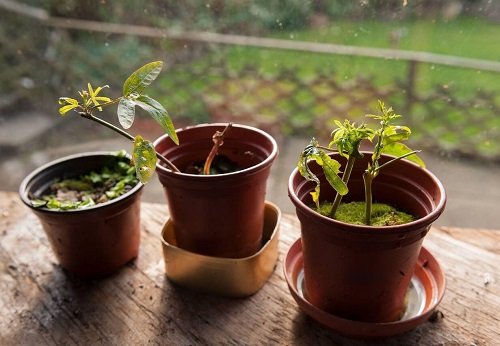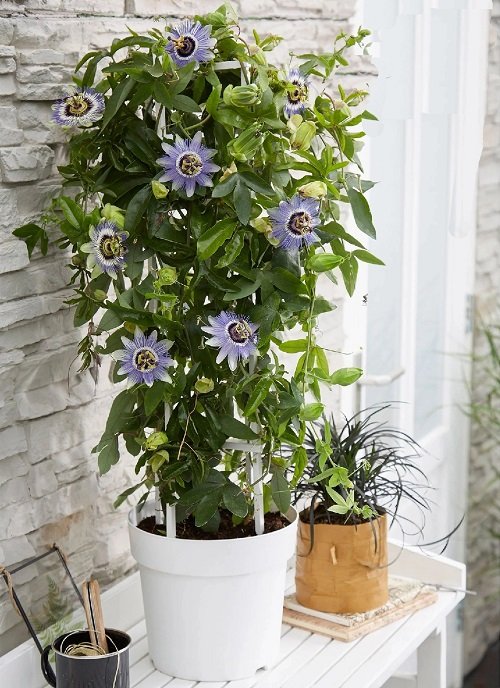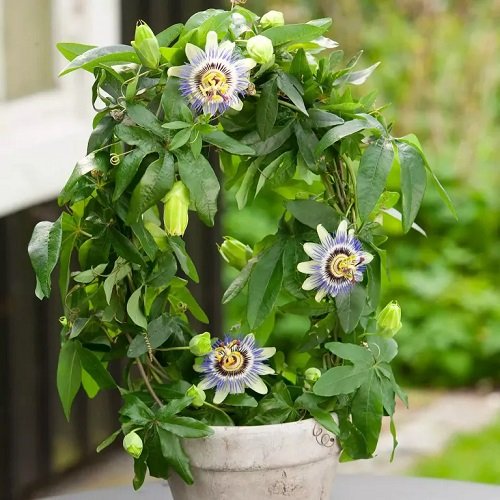Passiflora Caerulea stands out with its flowers that match perfectly with its green tropical foliage. Here’s all about growing Blue Passion Flower!
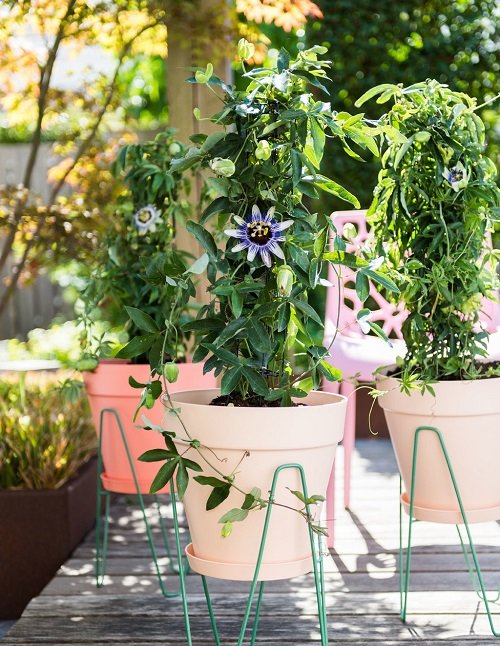
Passiflora Caerulea is a beautiful vine with ornamental flowers that add color and charm to any garden or, sometimes, to a small open indoor space like a shaded balcony or patio. To help it flourish and stay healthy, discover what it needs in this informative article.
Common Names: Passionflower, blue passion flower, passion fruit, Jesus flower
Botanical Name: Passiflora caerulea
USDA Zones: 8-11
Read about Passiflora Colinvauxii Plant Care here
Passiflora Caerulea Information
Passiflora caerulea flower, commonly known as the blue passion flower, is a species of flowering plant native to South America.
Origin
- Historical Roots: Passiflora caerulea flower has a long history of traditional use among indigenous peoples in South America, who recognized its medicinal properties and symbolic significance. Valued in traditional medicine for its calming effects, it found application in alleviating anxiety and sleep disorders, passed down through generations.
- Cultural Significance: The passion flower held spiritual meaning for indigenous tribes, symbolizing connections with the divine, fertility, and the cosmos.
Flowers
- Appearance: Passiflora caerulea flowers are a captivating blend of elegance and complexity, characterized by intricate blue and white petals surrounding a central arrangement of filaments and a distinctive corona, creating a visually enchanting and ornate appearance.
- Blossom Time: Passiflora caerulea typically blooms from early summer to late fall, gracing the landscape with its mesmerizing flowers for an extended period, attracting pollinators with its alluring hues and intricate structure.
Fruit
- Shape and Size: The passiflora caerulea fruit, known as passionfruit or passionflower fruit, is typically small to medium-sized, ranging from about 2 to 3 inches (5 to 7.5 cm) in diameter. It is generally round to slightly oval in shape.
- Color: The fruit’s outer skin can vary in color depending on the cultivar and ripeness. It often starts green and transitions to shades of orange or yellow as it matures.
- Interior: Inside the passiflora caerulea fruit, you’ll find a cavity filled with juicy, gelatinous pulp. The pulp can vary in color, ranging from pale yellow to deep orange, and contains numerous small, edible seeds.
Taste
- Raw Taste: The raw passiflora caerulea taste is a unique blend of sweet and tart flavors. The pulp is juicy, fragrant, and has a pleasantly tangy quality, which can vary in intensity based on the fruit’s ripeness.
- Cooked Taste: When cooked or used in culinary preparations, the taste of Passiflora caerulea’s passionfruit becomes more concentrated and complex. The cooking process can mellow out the tartness slightly, allowing the sweet and fruity flavors to come out.
Length and Growth
- Length: Passiflora caerulea can usually grow up to 15 to 40 feet (4.5 to 12 meters) in length, depending on the growing conditions and care it receives.
- Growth Habit: This vine tends to grow rapidly and may spread out widely, especially if provided with a suitable support structure to climb, like a trellis or fence. This is why we also added it to our list of best vines for containers.
Check out the best Types of Passionflower Vines here
Best Passiflora Caerulea Varieties
While Passiflora caerulea itself is a specific species known for its beautiful blue and white flowers, there are some variations and cultivars that offer subtle differences in appearance and growth habit.
- Passiflora caerulea ‘Constance Elliot’: A cultivar with pure white flowers, lacking the typical blue tinge.
- Passiflora caerulea ‘Clear Sky’: Offers larger blue and white flowers compared to the typical species.
- Passiflora caerulea ‘Chinensis’: Known for its bluish-purple flowers and distinct fragrance.
Propagating Passiflora Caerulea
Passiflora caerulea can be propagated by seeds, cuttings, or layering.
Ways to Propagate Passiflora Caerulea Flower
- Seed Propagation: Seeds can be collected from mature Passiflora caerulea fruit and sown in a well-draining potting mix. Keep the soil consistently moist and provide warmth and indirect light for germination. This method allows you to grow plants with genetic diversity, but it can take longer for the plants to reach maturity and produce flowers.
- Softwood Cuttings: Softwood cuttings involve taking young, flexible stem cuttings in spring or early summer. Remove leaves from the lower portion and dip the cut end in the rooting hormone. Plant the cutting in a well-draining medium and keep it humid until roots develop. This method can result in faster growth and flowering compared to seed propagation.
- Layering: Layering is done by bending a lower part of the low-growing stem of the Passiflora caerulea into a small trench, securing it with a U-shaped pin or weight, and covering it with soil. Once roots develop at the buried portion, the new plant can be separated from the parent. This method ensures the new plant is already rooted when separated, improving its chances of successful growth.
- Air Layering: Air layering involves creating a wound on a healthy stem, treating it with rooting hormone, and wrapping it with moist sphagnum moss or coco peat (and sometimes some people even use soil) and plastic wrap. Roots develop at the wounded portion, and once they’re well-established, the new plant can be severed from the parent and potted up. Air layering is a reliable method for obtaining a rooted plant with a high chance of survival.
- Division: Mature Passiflora caerulea plants can be divided into smaller sections with well-established root systems. Gently remove the plant from its pot, separate the sections, and repot them individually. This method is easy but suitable for plants that have grown large and may require rejuvenation or propagation.
The Most Popular and Reliable Method: Softwood Cuttings
Among the methods listed, softwood cuttings are generally the most popular and reliable method for propagating Passiflora caerulea. Softwood cuttings are widely used because they allow you to clone a plant with the same characteristics as the parent.
Steps to Grow Passiflora Caerulea from Softwood Cuttings
- Choose a healthy parent plant with vigorous growth and disease-free foliage. Select softwood stems that are about 4-6 inches long, ideally with 2-3 sets of top leaves.
- Make a diagonal cut just below a leaf node, ensuring the cutting has a node (the point where leaves attach to the stem). Remove the lower leaves, leaving only a few sets of leaves at the top.
- Fill small pots or containers with a well-draining potting mix. A mix containing perlite or sand can aid drainage.
- Insert the cut end of the softwood cutting about 1-2 inches deep into the soil, ensuring the node is below the soil surface.
- Water the soil gently after planting to settle it around the cutting. Place a clear plastic bag or a plastic dome over the pot to create a humid environment.
- Check for root development after a few weeks. Gently tug on the cutting; resistance indicates roots are forming.
- Once the cutting has developed a good root system, transplant it into a slightly larger pot with regular potting soil.
Propagate Any Plant Cutting Quickly Using this Trick
Advantages of Softwood Cuttings
- Faster Rooting: Softwood cuttings are taken from young, actively growing stems that contain a higher concentration of plant hormones. This makes them more receptive to root formation and generally leads to faster rooting than more mature cuttings.
- Genetic Uniformity: Softwood cuttings are essentially clones of the parent plant, ensuring that the new plants will closely resemble the original plant in terms of characteristics such as flower color, leaf shape, and growth habits.
- Higher Success Rate: Softwood cuttings are more likely to root successfully due to their physiological state. This higher success rate can be especially beneficial for hobbyists or gardeners who are new to propagation.
Choosing a Container for Passiflora Caerulea
Opt for a pot that provides adequate space for both root development and vertical growth. Initially, a container with a capacity of around 5 gallons is suitable for young Passiflora caerulea vine; this will allow the roots to spread comfortably. As the plant matures, you might need to consider repotting the vine to larger containers to accommodate its growth.
Additionally, select a container according to your choice and comfort. A plastic pot or something with castors would be more suitable if you need to move. You can also go with traditional terracotta pots or even try concrete planters. Everything is up to your budget and feasibility; overall, this vine is easy to grow and doesn’t mind the material of the container.
Here are Plant Pot Sizes from Inches to Gallon
When to Plant Passiflora Caerulea?
The ideal time to plant a Passiflora Caerulea flower outdoors is from mid-spring to fall, taking into account the prevailing climate in your area.
1. Planting in Frost-Free Climates (USDA Zones 10-12)
In tropical or subtropical regions where frost is never a concern, Passiflora Caerulea enjoys more flexibility in planting time. However, there are still optimal periods to consider:
Spring Planting
- Time: Early to mid-spring.
- Reason: Spring planting allows the passionflower to take advantage of the growing season, establishing a robust root system and thriving in warm temperatures.
Summer Planting
- Time: Early summer, avoiding the peak heat.
- Reason: Planting in early summer gives the plant time to settle before the most intense heat, but it’s still within a period where growth and establishment are optimal.
Autumn Planting
- Time: Early to mid-autumn.
- Reason: The milder temperatures of autumn can also be a good planting time in frost-free regions, allowing the roots to establish without the stress of extreme heat or cold.
Avoid Mid-Summer and Peak Heat Planting: Planting during the peak heat of summer can cause stress to the young plant, so it’s often avoided or done with great care to the watering and shading requirements.
Check out some stunning small flowering vines for trellises here
2. Planting in Warm Climates (USDA Zones 8-10)
In regions with warm and temperate climates, where frost is rare or nonexistent, Passiflora Caerulea can be planted almost year-round. However, some specific considerations are beneficial.
Spring Planting
- Time: Early to mid-spring, after the danger of any unseasonal frost has passed.
- Reason: Planting in spring allows the plant to establish its root system during the growing season, maximizing growth and bloom potential.
Autumn Planting
- Time: Early to mid-autumn, before any chance of cooler weather.
- Reason: Planting in autumn can allow the plant to establish roots without the stress of extreme heat, but sufficient time before any cool weather is essential.
3. Planting in Cold Climates (USDA Zones 5-8)
In colder climates, where frost and freezing temperatures are regular seasonal occurrences, the timing of planting Passiflora Caerulea is more critical:
Spring Planting
- Time: Late spring, after the last expected frost date.
- Reason: Planting after the last frost ensures that the tender new growth is not damaged by freezing temperatures. It gives the plant the full growing season to become established before winter.
Avoid Autumn Planting: In cold climates, autumn planting is typically avoided for Passiflora Caerulea, as it may not provide the plant enough time to establish itself before winter’s harsh conditions.
Can Passiflora Caerulea be Grown Indoors?
Passiflora Caerulea can thrive year-round when grown in a pot indoors, but it is crucial to ensure that it receives a few hours of full sunlight exposure for a minimum of 4-5 hours every day.
It is important to maintain well-draining and moist soil for the plant and to provide it with proper support to grow by pruning it and providing a suitable trellis or other means of support.
Requirements for Growing Passiflora Caerulea
Sunlight
- Intensity: Passiflora caerulea flower thrives in full to partial sunlight. It prefers a location that receives at least 5-6 hours of direct sunlight daily for optimal growth and flowering.
- Protection: While Passiflora caerulea enjoys sunlight, it benefits from protection against harsh elements.
- However, providing some shade during the hottest part of the day in regions with intense sunlight can help prevent leaf scorch and stress. Additionally, placing the plant near a wall or fence that provides wind protection can help prevent damage to delicate stems and tendrils.
Take a look at the Best Outdoor Indirect Sunlight Plants for Containers & Shade Gardens here
Soil
- Type: Passiflora caerulea flower thrives in well-draining soil that is rich in organic matter. A balanced mix of potting soil, perlite, and compost can create an ideal growing medium.
- Ph Level: Passiflora caerulea prefers slightly acidic to neutral soil pH levels ranging from 6.0 to 7.2. This pH range supports optimal nutrient uptake and overall plant health.
Learn How to Check the Soil pH at Home here
Watering
- Frequency: Water the plant when the top inch of soil feels dry to the touch. In warmer months, this might mean watering every couple of days, while in cooler months, it could be less frequent, around once a week, or even more if the plant is growing in the shade.
- Method: Water Passiflora caerulea deeply and evenly, making sure the entire root ball is moistened during each watering session. Water the soil directly rather than overhead, as wet foliage can lead to fungal issues. Using a soaker hose or a drip irrigation system is ideal, as it delivers water directly to the soil without wetting the leaves.
Temperature
- Range: Passiflora caerulea flower prefers a temperate to subtropical climate with average temperatures ranging from 65°F to 85°F (18°C to 29°C) during its growing season. The plant can tolerate hot temperatures up to 100°F (38°C) easily and short periods of cooler temperatures down to around 32°F (0°C), but prolonged frost can damage or kill the plant.
- Protection: During colder periods, especially in regions with temperatures near or below freezing, blue passion flower vine requires protection to prevent damage. If grown in containers, consider moving the plant indoors or to a sheltered location when frost is expected. For plants in the ground, covering them with frost cloth or burlap can help insulate them against freezing temperatures.
Here are the best ways to water plants
Passiflora Caerulea Care
Fertilizer
In-Ground Planting
- Frequency: Fertilize your plant every 7-9 weeks during the active growing season (spring and summer) to support its vigorous growth and flowering. Reduce or suspend fertilization during the non-growing season, as the plant’s nutrient requirements are lower.
- Type: Use a balanced, slow-release granular fertilizer with an N-P-K ratio of around 10-10-10 or 14-14-14. This provides essential nutrients for overall plant health. You can also go for well-rotted manure.
- Method: Spread the granular fertilizer evenly around the base of the plant but slightly away from the roots to ensure that the nutrients reach the root zone. Water the area after applying the fertilizer to help it penetrate the soil.
Container Planting
- Frequency: Fertilize potted Passiflora caerulea every 4-5 weeks during the growing season. Container plants may require more frequent feeding due to the limited soil volume. Similarly, decrease the frequency of fertilization during the non-growing season for potted plants. You may not need to fertilize at all in peak summer in a hot region and during fall and winter if you live in a cool climate.
- Type: Use a water-soluble, balanced fertilizer formulated for flowering plants. Look for an N-P-K ratio around 10-10-10 or similar.
- Method: Dissolve the recommended amount of fertilizer in water and apply it to the soil according to the package instructions. Ensure the soil is well-moistened and that excess fertilizer doesn’t accumulate in the pot.
Support
Due to its tendency to twine and climb, providing a strong trellis, arbor, or fence is essential to guide Passiflora caerulea flower vines upwards. These structures not only aid the plant’s growth but also showcase its striking flowers and lush foliage in an organized manner.
Ensuring that the support is securely anchored and well-constructed allows the plant to develop a robust framework that prevents tangling and enhances overall aesthetics.
Here are the Best DIY Trellis for Plants Ideas (Indoors and Outdoors)
Pruning
Regular pruning, typically done in late winter and up to mid-spring, it involves removing dead, diseased, or tangled growth to improve air circulation and reduce the risk of pests and diseases. Trimming back overly vigorous or tangled vines on the Passiflora caerulea flower also promotes a more organized and attractive growth habit.
Additionally, judicious pruning encourages the plant to allocate its energy toward new growth and flower production, resulting in a profusion of eye-catching blossoms during the growing season.
Pests
- Aphids: Tiny insects that suck sap, causing distorted leaves and honeydew secretion.
- Whiteflies: Small flying insects that gather under leaves, leading to yellowing and virus transmission.
- Spider Mites: Tiny arachnids that create webbing and puncture cells, causing stippling and discoloration.
- Scale Insects: Immobile bumps that suck sap, leading to yellowing, honeydew, and sooty mold.
- Mealybugs: Soft, white insects that cluster and feed on sap, secreting honeydew.
Thrips: Tiny insects that rasp and suck plant tissue, causing streaks and deformities.
Diseases
- Powdery Mildew: Fungal disease that forms a white, powdery growth on leaves, reducing photosynthesis and weakening the plant.
- Leaf Spot: Fungal or bacterial pathogens cause circular spots on leaves, leading to defoliation if severe.
- Root Rot: Fungal infection that attacks roots, causing wilting, yellowing, and overall decline.
- Botrytis Blight: Gray mold fungus causing brown spots, decay, and damping-off in cool, damp conditions.
- Downy Mildew: Fungal infection that results in yellow patches on leaves, often accompanied by white, fuzzy growth on the undersides.
Passiflora Caerulea Uses for Landscaping
1. Accentuating Vertical Spaces
Utilizing its climbing nature, Passiflora caerulea can be trained on trellises, pergolas, or fences. Its ability to cover vertical spaces can be a prominent design feature.
2. Creating Natural Screens
Its vigorous growth makes it suitable for creating privacy screens. Planting it along fences or other structures can create a beautiful and dense visual barrier.
3. Incorporation in Mixed Borders
Its exotic flowers can be used as an accent in mixed borders, adding contrast and excitement to traditional garden beds.
4. Containers and Potted Displays
Passiflora caerulea can be grown in large containers, especially in regions where it might not survive the winter outdoors. This allows for mobility and adds a tropical touch to patios or decks.
5. Wildlife Attraction
Its flowers are known to attract pollinators such as butterflies and bees, enhancing the ecological value of the garden.
6. Great Theme Garden Plant
It can be a centerpiece in tropical or exotic-themed gardens due to its unique and vibrant appearance.
7. Integration into Spaces with Water Features
Planting it near ponds or fountains can provide a calming and tropical ambiance. Care must be taken to provide support for its climbing habit.
Harvesting Bluecrown Passionflower Fruit
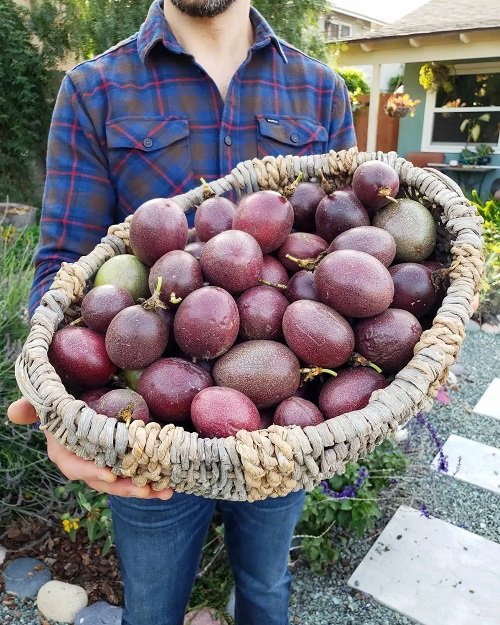
The fruit of Passiflora Caerulea has an intense, sweet flavor and is popular for making jams, jellies, and preserves.
Days to Harvest
Passiflora caerulea‘s passionfruit typically takes around 80 to 90 days to reach maturity from the time of flowering.
Signs the Fruit is Ready to be Picked
- Color: The fruit’s outer skin changes from green to shades of orange or yellow, indicating ripeness.
- Fragrance: A strong, sweet aroma emanates from the ripe fruit, signaling readiness for harvest.
- Texture: Gently pressing the fruit reveals a slight give or softness, suggesting that it’s ripe.
- Taste: When the pulp inside becomes sweet-tart, and the flavor is rich and aromatic, the fruit is ready to be enjoyed.
Check out 26 Types of Passionflower Vines here
Storing Bluecrown Passionflower Fruit
- Wash the fruit gently to remove any dirt or debris. Pat the fruit dry with a clean cloth or paper towel.
- Keep ripe passionfruit in the refrigerator’s crisper drawer to prolong freshness.
- If not used immediately, store the fruit whole to maintain its flavor and quality.
- For longer storage, place the fruit in a paper bag with ventilation holes to prevent moisture buildup.
- For more extended storage, scoop out the pulp, freeze it in portions, and store it in airtight containers.
Overwintering Passiflora Caerulea
To overwinter Passiflora Caerulea plant, it is important to provide it with a sheltered location and to cover it with frost protection such as mulch or burlap. The vine should also be pruned back to encourage more compact growth.
Additionally, keep the soil moist but not waterlogged and fertilize with a balanced feed to promote healthy growth. Be sure to water any containers regularly and adjust their location as needed to provide the plant with the optimal amount of sunlight.
Check out great tips on how to keep houseplants alive in winters here
Lastly, it is important to monitor Passiflora Caerulea for any signs of pests or disease and act accordingly to prevent any issues from arising.
FAQs
1. Caring for a Passiflora Caerulea Flower
To care for Passiflora caerulea, provide it with full to partial sunlight and well-draining soil. Regularly water to keep the soil slightly moist and ensure proper drainage to prevent waterlogging. Support its climbing habit with a sturdy trellis or structure. Watch for pests and diseases, and fertilize with a balanced, slow-release fertilizer during the growing season. The captivating passion flower vine will reward you with its unique beauty and fragrance.
2. How to Grow Passiflora Caerulea from Seeds?
To grow Passiflora caerulea from seeds, collect mature seeds from the fruit, clean them, and soak them in water for a few hours. Plant the seeds in well-draining soil and keep the soil consistently moist. Maintain a warm and bright environment for the seedlings. Transplant them carefully once they develop a few sets of true leaves, and provide support for their climbing growth as they mature.
3. Is Passiflora Caerulea Edible?
Yes, Passiflora caerulea, produces edible fruit. The fruit, often referred to as passionfruit, contains juicy and flavorful pulp that can be enjoyed fresh or used in various culinary creations. The pulp is sweet-tart and has a tropical citrus taste. It’s used in beverages, desserts, jams, and sauces, adding a delightful tropical flavor to dishes.
Best Edible Long Stemmed Mushrooms
4. Is Passiflora Caerulea Poisonous?
Passiflora caerulea flower is generally considered non-toxic to humans. While some Passiflora species contain compounds that may cause mild stomach discomfort if ingested in large quantities, Passiflora caerulea’s fruit is known to be safe for consumption. However, it’s important to exercise caution when consuming any wild or unfamiliar plant.
5. Passiflora Caerulea Benefits
Passiflora caerulea, or Blue Passionflower, offers a range of benefits. Its ornate flowers enhance aesthetics while attracting pollinators, which aids in biodiversity. The edible passionfruit adds a tropical flavor to culinary creations. Its climbing growth makes it suitable for privacy screens, and its cultural significance, along with potential medicinal use, adds to its overall value.


